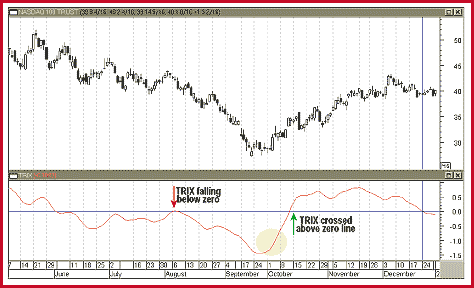BASIC TECHNIQUES
Triple-Smoothed Exponential Moving Averages And Percent Rate Of Change
TRIX Is For Traders
by David Penn
This momentum indicator keeps you in trends for as long as you like.
A drawback of moving average-based indicators has always been the lag: Moving averages often provide buy and sell signals long after much of a big move has already occurred. Although this is a relative complaint - is it better to be early and often wrong, or late and often correct? - it is significant enough that some traders seek to get more out of moving averages. Weighting and exponentially smoothing moving averages are among the methods used to get moving averages to yield buy/sell signals more quickly.
On the other hand, many traders who prefer to catch big moves at the beginning (and to exit them before they end) also choose rate of change indicators. Those indicators are prized for their ability to signal just when momentum has changed, like a shift from prices in a trading range to sudden action that can point to the direction of a new trend.
Unfortunately, momentum indicators also have drawbacks. Because momentum or rate of change slows and speeds up in every trend, momentum-only indicators can shake traders out of positions just when markets begin to trend strongly. For example, conditions that would otherwise be considered overbought when a market is moving sideways are often standard fare for advancing markets. Similarly, strongly downward-trending tradables will often have continuously oversold momentum indicators.

FIGURE 1: The TRIX indicator. A sell signal is given in early August. A TRIX bottom in late September hints at an excellent time to buy the QQQ.
...Continued in the March 2002 issue of Technical Analysis of STOCKS
& COMMODITIES
David Penn is a Staff Writer for STOCKS & COMMODITIES.
Excerpted from an article originally published in the March 2002 issue of Technical Analysis of STOCKS & COMMODITIES magazine. All rights reserved. © Copyright 2002, Technical Analysis, Inc.